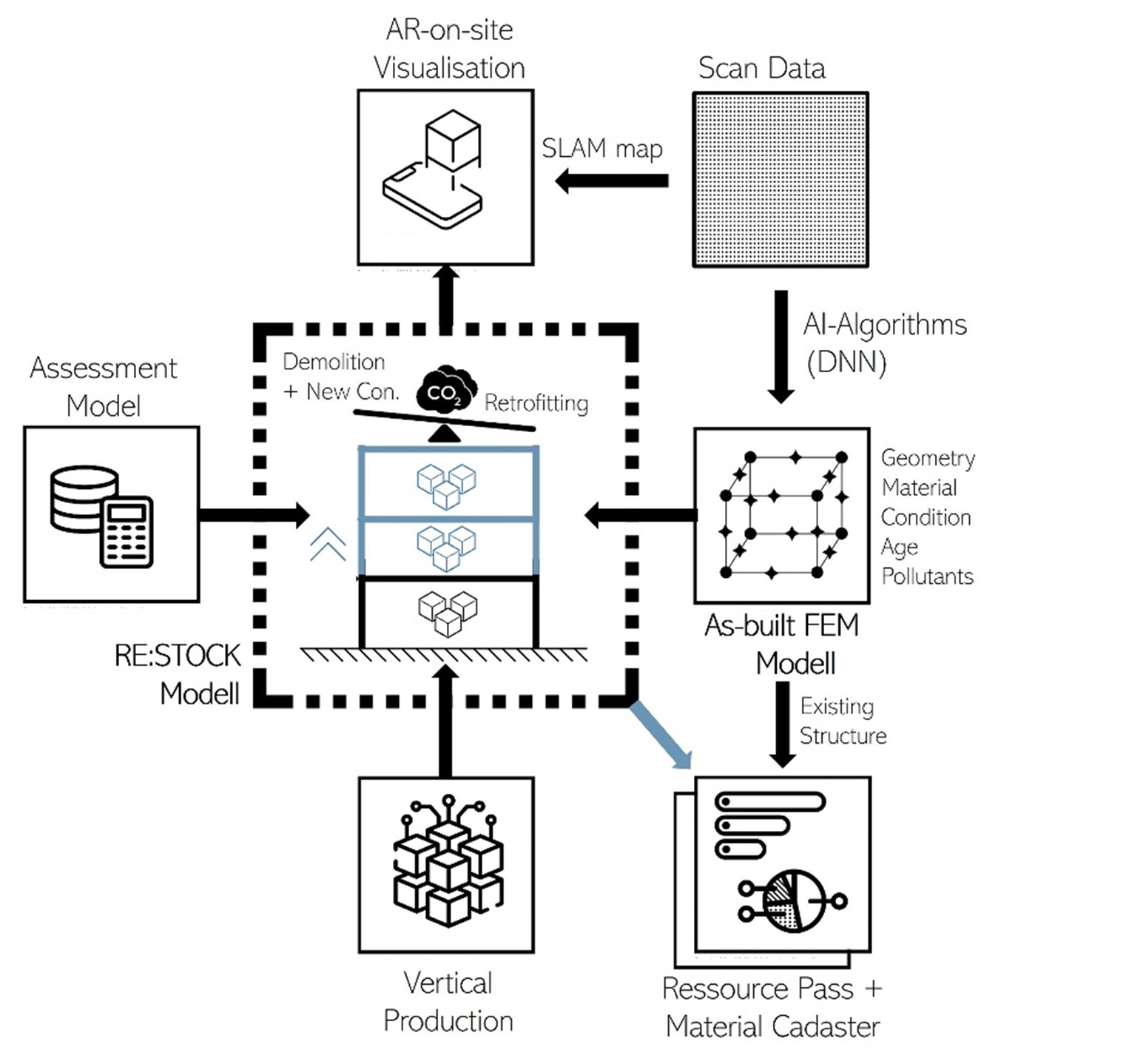RE:STOCK INDUSTRY - Digital framework for the circular reuse of existing structures for vertical production
Short Description
Starting point / motivation
The strong growth of the Austrian industry leads to increased construction activity and land sealing. The construction sector accounts for 60% of raw material extraction, 40% of energy-related CO2 emissions and 70% of waste generated in Austria comes from construction sec-tor - facts that call for sustainable use and reuse of existing infrastructures. Even though there are more than 82200 existing industrial and warehouse buildings, 20000 ha of unused industrial land and 6000 vacant industrial buildings, new production settlements/expansions are rarely integrated into existing structures. Concepts for the implementation of vertical production processes and, consequently, vertical upgrading of existing industrial buildings could significantly reduce waste generation and land sealing. The load-bearing structure of the buildings is of crucial importance. There is a lack of information on the actual load-bearing capacity and usability for reuse and of methods for precise capturing and life-cycle-oriented assessment of the structural building stock.
Contents and goals
The overall goal of RE:STOCK INDUSTRY is to strategically reuse the load-bearing structure of industrial buildings during new establishments, expansions, or repurposing, rather than resorting to recycling or disposal processes. By introducing innovative vertical production concepts and integrating them into potential analyses of the existing structural system, the project aims to prevent new land sealing and extend the lifespan of industrial structures. The research objective is to develop a comprehensive digital method for capturing, modeling, and analyzing the existing load-bearing structure of industrial buildings. This method aims to determine their potential for reuse, modernization, and enhancement during vertical expansions, all while considering aspects of the circular economy.
Methodological approach
In the project, missing automated methods for Scan to FEM (Finite Element Method) using Artificial Intelligence (AI) algorithms are being developed. The generated as-built FEM models, enriched with precise geometry and material properties, will serve not only for traditional structural analysis but also for the circular-oriented documentation and evaluation of the structure's reusability. Innovative approaches for vertical enhancements of industrial buildings and tailored concepts for vertical production and storage processes within existing structures are explored. A digital method is being developed to seamlessly integrate vertical production concepts into FEM models, depicting modernization and enhancement measures with simultaneous cost and sustainability feedback. An interactive Augmented Reality (AR) application enables the visualization of reusability concepts with real-time feedback directly at the potential construction site, encouraging planners and builders to opt for enhancement instead of demolition and new construction.
Expected results
The innovation lies in the integration of various methods within a framework: the application of AI algorithms for automated generation of as-built FEM models from scan data, the incorporation of vertical 3D production concepts into structural analysis, methods for assessing and documenting structure-relevant information for building reusability, and the integration of AR technology as a visual decision support for re-use evaluation. Building owners receive a tool for digital documentation and analysis of the load-bearing structure of their industrial buildings, enhancing awareness of circular economy utilization. Implementing these proposed methods in practice will sustainably modernize and enhance the existing industrial building stock under vertical usage, prolonging the lifespan of structures and mitigating new land sealing. The results will have long-term relevance for other building types where automated capturing and analysis of existing structures for enhancement are required, such as office buildings, schools, or residential constructions.
Project Partners
Project management
Dipl. Ing. Dr. techn. Julia Reisinger
TU Wien, Institute of Building and Industrial Construction - Integrated Planning and Industrial Building
Project partners
- ATP Wien Planungs GmbH
- Delta Projektconsult GmbH
- diebauplaner salzer&partner zt GmbH
- Fraunhofer Austria Research Gesellschaft mit beschränkter Haftung
- Palfinger Structural Inspection GmbH
- RM Umweltkonsulenten ZT GmbH
- TU Wien, Institute of Visual Computing and Human-Centered Technology
Contact Address
Dipl. Ing. Dr. techn. Julia Reisinger
TU Wien, Institute of Building and Industrial Construction - Integrated Planning and Industrial Building
Karlsplatz 13/E210-01, 1040 Wien
Tel.: +43 1 58801 21522
E-Mail: Julia.reisinger@tuwien.ac.at
Website der TU Wien

